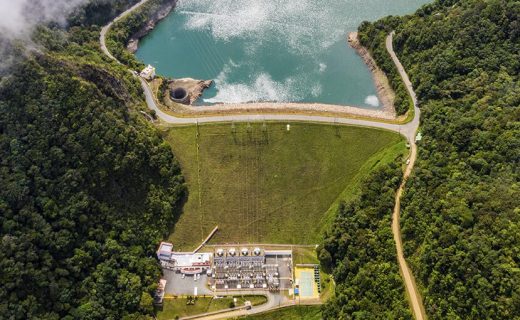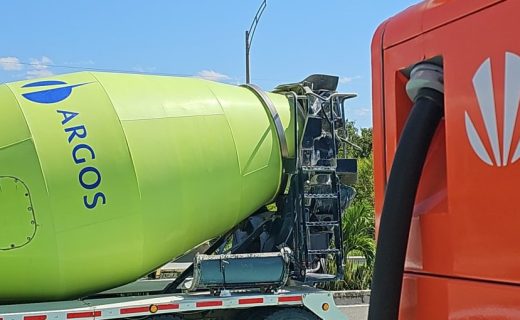

Brand • Corporate
Colombian Pride: On February 27, Grupo Argos celebrates its 90th anniversary and reaffirms its leadership in 21 countries and territories across the Americas.
27 February 2024- In 1934, Jorge Arango Carrasquilla and Carlos Sevillano Gómez made the decision to start a venture to enable Colombia to produce the cement needed to build its cities and industries.
- The company, which began with an installed capacity of 15,000 tons, has grown to more than 24 million tons, with 40 million vehicles traveling through the company’s road concessions, 45 million people using its airport concessions, and 1.3 million customers served by its energy business. Today, it is an organization with over 11,000 employees, presence in 21 countries, and manages approximately COP 50 trillion in assets.
- Over these 90 years, Grupo Argos has driven industrial growth and infrastructure development in Colombia and the region, based on a business vision centered on generating economic value in balance with social well-being and environmental care.
On February 27, 1934, the “Compañía de Cemento Argos” was established in Medellín, focused on “exploiting the cement industry and producing any other materials or articles based on lime or clay…”. 90 years later, Grupo Argos is a benchmark in infrastructure and a significant player in the construction materials, energy, real estate income, and road and airport concessions industries.
In the late 1920s and early 1930s, amidst a global financial depression, visionary entrepreneurs dreamed of creating a large company that would boost housing growth and civil works in Colombia. For several years, they explored different areas of Antioquia on mule-back to identify limestone and other mineral deposits while advancing the structuring and socialization of what would be named Cemento Argos.
Faced with the challenge of capital scarcity for this venture, the founders turned to regional cooperation, which led to the creation of significant assets in Colombia, involving 99 partners, both individuals and legal entities, who not only provided enough capital to start construction of the factory and commence operations two years later but also offered the confidence to continue creating and strengthening the national industry.
Participation in the creation of regional cement factories. In its early years, Cemento Argos rapidly expanded its productive capacity to meet growing demand in Colombia. Studies extended to other regions, revealing the potential of lands around the Magdalena River, as well as in Valle del Cauca and the Caribbean Coast. In 1938, in collaboration with investors from Valle del Cauca, Cemento Argos participated with a 30% stake in the foundation of Cementos del Valle, whose plant began operations in 1941, marking the start of a series of partnerships that would establish it as a national company. In the following years, Argos promoted the creation and strengthening of other companies like Cementos del Caribe, Cementos de Caldas, Tolcemento, Colclínker, Cementos Paz del Río, Cementos del Nare, Cementos El Cairo, and Cementos Rioclaro.
Internationalization process. Between the late 20th century and early 21st century, Colombia accelerated its economic opening process, enabling a focus on geographical diversification. Initially, capabilities were developed to export to the Caribbean basin and several states in the United States. Subsequent alliances led to the acquisition of cement companies in Panama, the Dominican Republic, Haiti, and Venezuela.
Entry into the United States with direct operations, merger of cement companies, and entry into the energy and concessions industries. The leadership and long-term vision drove Grupo Argos to build a platform of cement, concrete, and logistics assets in 12 states of the world’s leading economy between 2005 and 2016.
Meanwhile, in Colombia, the market had changed, presenting challenges that led the eight regional cement companies created or acquired by Cemento Argos to merge into a single company. This milestone paved the way for Cementos Argos, focusing on the cement and concrete business, and Grupo Argos, which owned 70% of the company’s shares and later received various non-cement investments. Grupo Argos focused on developing alternative and complementary industries to the cement business, consolidating four strategic businesses: cement with Cementos Argos, energy with Celsia, road and airport concessions with Odinsa, and real estate income with Pactia and the Urban Development Business.
Looking to the future: asset combination with Summit Materials and consolidation of infrastructure asset management platforms. In 2024, Argos USA and Summit Materials merged their assets, resulting in a company with an approximate enterprise value (EV) of USD 9 billion, listed on the New York Stock Exchange, in which Cementos Argos holds a 31% stake. This move valued the company’s operations in the United States at around USD 3.2 billion and opens new opportunities for the organization and Colombia in that country.
The new combined entity has 5.5 billion short tons of aggregates, equivalent to more than 90 years of reserves, giving Cementos Argos immediate exposure to a sector in which it previously had no significant exposure. Similarly, this new company has 11.8 million tons of installed cement capacity, 224 concrete plants, 32 asphalt plants, and presence in 30 states.
Over the last five years, Celsia and Odinsa have also made exponential progress in the organization’s strategy by forming and consolidating investment platforms in energy generation, transmission, distribution, roads, and airports, attracting global capital to meet infrastructure development needs in Colombia and the region. Strategic partners such as Cubico Sustainable Investments and Macquarie Asset Management, the world’s largest infrastructure investment fund, participate in these platforms.
Today, Celsia serves more than 1.3 million residential customers in Valle del Cauca and Tolima, is the fourth largest energy generator in Colombia with a matrix of over 70% renewable energy, and is a leader in the energy transition in the country and the region, with over 300 MW of installed solar generation capacity and more than 400 MW in development.
Odinsa manages concessions through which more than 40 million vehicles and over 45 million passengers traveled in 2023. The company’s road and airport verticals also have a portfolio of USD 4.5 billion in projects that will transform the region’s infrastructure over the next 10 years.
The story of Grupo Argos is that of thousands of Colombian entrepreneurs who work every day to generate economic value while building companies and the country. The legacy of this company, owned by more than 15,000 shareholders, including over 18 million pension fund savers, can be seen in each of the infrastructure works that represent well-being throughout the continent.
Where there is progress, well-being, and development, there is Grupo Argos.
Mas noticias
-
 Corporate
Corporate -
 Corporate
CorporateGrupo Argos and Grupo Sura sign a Spin-Off Agreement through which Grupo Argos shareholders will directly receive the company's investment in Grupo Sura
18 December 2024Grupo Argos and Grupo Sura sign a Spin-Off Agreement through which Grupo Argos shareholders will directly receive the company's investment in Grupo Sura
Read more -
 Brand
BrandGrupo Empresarial Argos' companies strengthened their performance in the S&P Global Sustainability Index and consolidated their leadership
30 September 2024Grupo Empresarial Argos' companies strengthened their performance in the S&P Global Sustainability Index and consolidated their leadership
Read more -
 Business
BusinessJorge Mario Velásquez has been recognized as one of the 500 most influential people in Latin America by Bloomberg Línea
18 September 2024Jorge Mario Velásquez has been recognized as one of the 500 most influential people in Latin America by Bloomberg Línea
Read more -
 Business
BusinessFor the second consecutive year, Grupo Argos stands out among the 1,000 best companies in the world according to TIME magazine and Statista
12 September 2024For the second consecutive year, Grupo Argos stands out among the 1,000 best companies in the world according to TIME magazine and Statista
Read more
